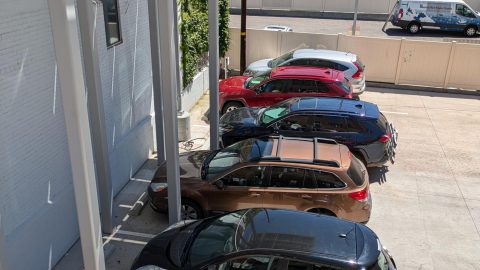By prioritizing public transportation, providing access to bike racks, and installing electric vehicle charging stations, we have ensured that traveling to and from the Climate Innovation Center results in minimal emissions. Installing EV charging that will be powered by our rooftop solar creates an ideal combination for zero emission transportation.
Key Considerations
One challenge of utilizing an existing building is that the amount of parking required by your local zoning code may be more than the number of parking spots you can fit onsite.
We worked with our architects to obtain a variance on the typical minimum parking requirements. Our strategies included: showing that our site is conveniently accessible by public transit, making bicycle commuting convenient for employees and guests, and encouraging employees to carpool and/or incentivizing employee use of public transportation.
As noted above, due to our very limited site, public transit is a key component of the transportation strategy for employees and guests. An incentive program will be provided to employees to encourage the use of public transportation.
Directions for using public transportation will be included in all event promotion hosted at the Climate Innovation Center.
We installed several bike racks, including hanging racks inside the building and covered outdoor racks. We also provided a power source for charging e-bikes.
Our office also has a shower for employees to use, making it possible for employees who commute by bike to look (and smell!) professional after a bicycle commute in hot weather.
For workplace charging, where employees will be staying put for at least several hours, level 2 charging will be sufficient to meet employee EV charging needs. We installed three level 2 EV chargers at the CIC.
Plan for low power (level 1) charging too. A low power option helps top up EV batteries that are not in need of a whole ton of power. For buildings like the CIC that are solar powered with battery storage, low power charging also makes it possible to charge EVs if the grid loses power.
Charging EVs can demand a lot of electricity, which can contribute to peak demand. This is a challenge for managing our costs and electric grid wisely. Selecting EV chargers that have the capability to be wired/set-up/programmed to limit the total electricity demand between the chargers at any one time helps manage peak demand and avoid peak demand charges.
We received guidance on selecting EV chargers that meet our needs from Leaders for Clean Air.





